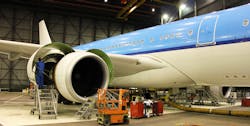How many engines do airlines go through in a typical lifespan?
AMSTERDAM - To answer what seems to be a relatively simple question, it is essential to understand the factors that define the life of an airliner and a jet engine. Airliners and jet engines are complex machines whose lifespan is difficult to determine in absolute flight cycles, flight hours, or operational years. Like any other machine, the manufacturers build them with a specific design limit. However, the actual lifespan depends on usage, operating conditions, and maintenance. Before getting into the specifics, here is a brief look into the lifespan of airliners and engines, Dr. Omar Memon informs for Simple Flying. Continue reading original article.
The Military & Aerospace Electronics take:
30 March 2023 - Dr. Memon, who holds a Ph.D. in aerospace engineering, goes through the typical lifecyle of wide- and narrowbody passenger jets in his piece for Simple Flying. He notes that shorter range narrowbody jets have a projected lifespan of 50,000 flight cycles. For widebodies, that varies between 25,000 and 45,000 flight cycles. On the military side, Dr. Memon cites an active flight life of 5-8,000 hours as they operate in extreme conditions.
"The average number of cycles before the first overhaul for modern narrowbody engines is 12,000 flight cycles," Dr. Memon writes. "For the two subsequent maintenance visits, the number of cycles may be reduced to 8,000 and 4,000, respectively. With an overhaul costing several million dollars, further shop visits could not be economically viable for operators. The average number of hours before the first overhaul for modern widebody engines is 20,000 flight hours. Subsequent maintenance visits reduce this number to as low as 5,000 flight hours."
Related: Pulse Aviation chooses Embraer-X's Beacon MRO platform
Related: Air China and Rolls-Royce announce new MRO facility in Beijing
Related: The hunt for MRO parts
Jamie Whitney, Associate Editor
Military + Aerospace Electronics
